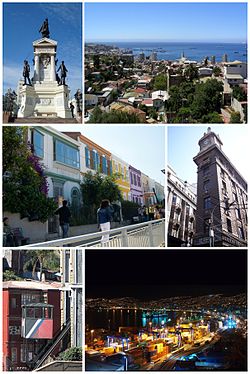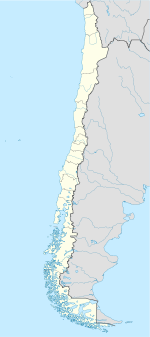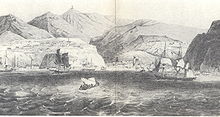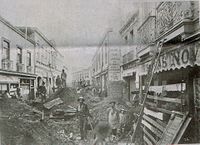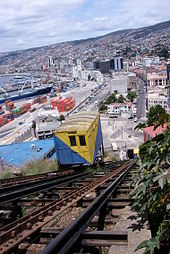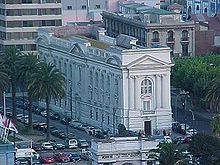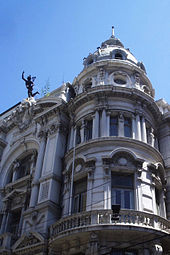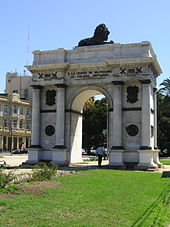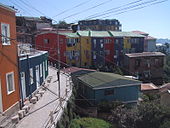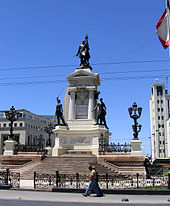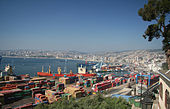
Valparaíso
Background to the schools Wikipedia
SOS Children, which runs nearly 200 sos schools in the developing world, organised this selection. Before you decide about sponsoring a child, why not learn about different sponsorship charities first?
| Valparaíso | |
|---|---|
| Montage of Valparaíso, Top left: A monument of Los Heroes de Iquique in Sotomayor Square, Top right:View of Downtown, include Ancha Beach, from Sebastiana Hills, Middle left:A façade residential built in Atkinson Street, Middle rightTurry Clock Tower in Cochrane area, Bottom left:A cablecar(funiculars) of Valparaíso in Concepcion Hills, Bottom right:Night View of Valparaíso Port and Errazuriz Avenue | |
| Nickname(s): The Jewel of the Pacific, Valpo | |
 Coat of arms |
|
|
|
|
 Flag |
|
| Coordinates (city): 33°03′S 71°37′W Coordinates: 33°03′S 71°37′W | |
| Country | Chile |
| Region | Valparaíso |
| Province | Valparaíso |
| Founded | 1536 |
| Capital | Valparaíso |
| Government | |
| • Type | Municipality |
| • Alcalde | Jorge Castro Muñoz |
| Area | |
| • City | 401.6 km2 (155.1 sq mi) |
| Elevation | 10 m (30 ft) |
| Population (2002) | |
| • City | 275,982 |
| • Density | 690/km2 (1,800/sq mi) |
| • Urban | 275,141 |
| • Metro | 930,220 |
| • Rural | 841 |
| Time zone | CLT ( UTC−4) |
| • Summer ( DST) | CLST ( UTC−3) |
| Area code(s) | (country) 56 + (city) 32 |
| Website | Official website (Spanish) |
Valparaíso ( / ˌ v æ l p ə ˈ r aɪ z oʊ /, Spanish: [balpaɾaˈiso]) is a city and commune of Chile, centre of its third largest conurbation ( Greater Valparaíso), is located 69.5 miles (111.8 km) northwest of Santiago and one of the country's most important seaports; it is an increasingly important cultural centre in the Southeast Pacific. The city is the capital of the Valparaíso Province and the Valparaíso Region. Although Santiago is Chile's official capital, the National Congress of Chile was established in Valparaíso in 1990.
Valparaíso played a very important geopolitical role in the second half of the 19th century, when the city served as a major stopover for ships traveling between the Atlantic and Pacific oceans by crossing the Straits of Magellan. Always a magnet for European immigrants, Valparaíso mushroomed during its golden age, when the city was known by international sailors as “Little San Francisco” and “The Jewel of the Pacific.”
Examples of Valparaíso’s former glory include Latin America’s oldest stock exchange, the continent’s first volunteer fire department, Chile’s first public library, and the oldest Spanish language newspaper in continuous publication in the world. The opening of the Panama Canal and reduction in ship traffic dealt a staggering blow to Valparaíso, though the city has staged an impressive renaissance in recent years.
Though nearby San Antonio has become the country’s most commercially important seaport in terms of tonnage moved, the City of Valparaíso remains a vibrant centre of Chilean culture. The Greater Valparaíso metropolitan area (which includes Valparaíso, Viña del Mar, Quilpué and Villa Alemana) has the third-largest concentration of population in the country after Greater Santiago and Greater Concepción.
History
Valparaíso's bay was probably first populated by Picunches Indians, who were dedicated to agriculture. Other accounts say that it was the Changos who were nomads dedicated to fishing, and traveling between Caldera and Concepcion. Spanish explorers arrived in 1536, aboard the Santiaguillo, a supply ship sent by Diego de Almagro, who is considered the first European explorer, or discoverer, of Chile. The Santiaguillo carried men and supplies for Almagro’s expedition, under the command of Juan de Saavedra, who named the town after his native village of Valparaíso de Arriba in Cuenca, Spain.
During Spanish colonial times, Valparaíso remained a small village, with only a few houses and a church. After Chile’s independence from Spain (1818), Valparaíso became the main harbour for the nascent Chilean navy, and opened to international trade, formerly limited to commerce with Spain and its other colonies.
Valparaíso soon became a desired stopover for ships rounding South America via the Strait of Magellan and Cape Horn. It gained particular importance supporting and supplying the California Gold Rush (1848–1858). In its role as a major seaport, Valparaíso received immigrants from many European countries, mainly from Britain, Germany, France, Switzerland and Italy. German, French, Italian and English were commonly spoken among its citizens, who founded and published newspapers in these languages.
International immigration transformed the local culture from Spanish origins and Amerindian origins. Football was introduced to Chile by English immigrants, and the first private Catholic school in Chile was founded by French immigrants in Valparaíso: Le Collège des Sacrés Cœurs (The Sacred Hearts School) which has been operating for about 170 years. Immigrants from Scotland and Germany founded the first private secular schools, ( The Mackay School, and Die Deutsche Schule, respectively). Immigrants formed the first volunteer fire-fighting units (still a volunteer activity in Chile). Their buildings reflected a variety of European styles, making Valparaíso more varied than some other Chilean cities.
In August 18, 1906; a major earthquake struck Valparaíso; there was extensive property damage and thousands of deaths. The Chilean doctor Carlos Van Buren, of U.S. descent, was involved in medical care of earthquake victims. He later established a modern hospital Carlos Van Buren Hospital in 1912.
The golden age of Valparaíso’s commerce ended after the opening of the Panama Canal (1914). Shipping shifted to the canal as captains sought to avoid the risks of the Strait of Magellan. The port's use and traffic declined significantly, causing a decline in the city's economy. Since the turn of the 21st century, shipping has increased in the last few decades with fruit exports, increasing opening of the Chilean economy to world commerce, and larger-scale, Post-Panamax ships that do not fit the Panama Canal.
The city was affected by the 27 February 2010 earthquake.
Geography
Valparaíso is located in central Chile, 120 km (75 mi) to the northwest of the capital Santiago. Valparaíso, like most of Chile, is vulnerable to earthquakes. Before the earthquake of February 27, 2010, which measured 8.8 on the moment magnitude scale, the last catastrophic earthquake to strike Valparaíso devastated the city in August 1906, killing nearly 3,000 people. Other significant earthquakes to affect the city were the 1730 Valparaíso earthquake, the 1985 Santiago earthquake and the 2008 Papudo earthquake.
Geology
Because of Valparaíso's proximity to the Peru-Chile Trench, the city is vulnerable to earthquakes. The Peru-Chile Trench stores large amounts of energy for a very long time and yet sometimes ruptures after short intervals in a violent earthquake.
Climate
Valparaíso has a very mild Mediterranean climate ( Köppen Csb) closely resembling that of San Francisco or Santa Barbara at a similar latitude in the northern hemisphere. The summer is essentially dry, but the city is affected by fogs from the Humboldt Current during most of the year. In the winter, rainfall can occasionally be extremely heavy when a powerful frontal system crosses central Chile, but frequency of such rains varies greatly from year to year.
| Climate data for Valparaíso, Chile | |||||||||||||
|---|---|---|---|---|---|---|---|---|---|---|---|---|---|
| Month | Jan | Feb | Mar | Apr | May | Jun | Jul | Aug | Sep | Oct | Nov | Dec | Year |
| Average high °C (°F) | 23 (73) |
23 (73) |
21 (70) |
19 (66) |
17 (63) |
16 (61) |
16 (61) |
16 (61) |
18 (64) |
18 (64) |
20 (68) |
22 (72) |
19.1 (66.3) |
| Average low °C (°F) | 13 (55) |
13 (55) |
12 (54) |
11 (52) |
10 (50) |
9 (48) |
8 (46) |
8 (46) |
10 (50) |
10 (50) |
11 (52) |
12 (54) |
10.6 (51) |
| Rainfall mm (inches) | 2 (0.08) |
2 (0.08) |
4 (0.16) |
18 (0.71) |
97 (3.82) |
128 (5.04) |
88 (3.46) |
67 (2.64) |
30 (1.18) |
16 (0.63) |
7 (0.28) |
3 (0.12) |
462 (18.2) |
| Avg. rainy days (≥ 0.1 mm) | 2 | 2 | 4 | 5 | 9 | 9 | 8 | 8 | 5 | 5 | 3 | 2 | 62 |
| % humidity | 72 | 74 | 76 | 78 | 80 | 80 | 80 | 79 | 78 | 75 | 71 | 70 | 76.1 |
| Mean monthly sunshine hours | 279.0 | 245.7 | 217.0 | 174.0 | 114.7 | 81.0 | 93.0 | 117.8 | 147.0 | 170.5 | 216.0 | 263.5 | 2,119.2 |
| Source: Climate & Temperature | |||||||||||||
Cityscape
| Historic Quarter of the Seaport City of Valparaíso | |
|---|---|
| Name as inscribed on the World Heritage List | |
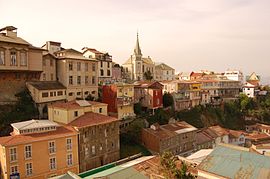 |
|
| Country | Chile |
| Type | Cultural |
| Criteria | iii |
| Reference | 959 |
| UNESCO region | Latin America and the Caribbean |
| Inscription history | |
| Inscription | 2003 (27th Session) |
Nicknamed “The Jewel of the Pacific”, Valparaíso was declared a world heritage site based upon its improvised urban design and unique architecture. In 1996, the World Monuments Fund declared Valparaíso’s unusual system of funicular elevators (highly-inclined cable cars) one of the world’s 100 most endangered historical treasures. In 1998, grassroots activists convinced the Chilean government and local authorities to apply for UNESCO world heritage status for Valparaíso. Valparaíso was declared a World Heritage Site in 2003. Built upon dozens of steep hillsides overlooking the Pacific Ocean, Valparaíso boasts a labyrinth of streets and cobblestone alleyways, embodying a rich architectural and cultural legacy. Valparaíso is protected as a UNESCO World Heritage Site.
Landmarks include:
- Iglesia de la Matriz
- Plaza Aníbal Pinto
- Plaza Sotomayor
- Courthouse
- 16 remaining funiculars (called ascensores): 15 public (national monuments) and 1 private (which belongs to "Hospital Carlos Van Buren").
- The Concepcion and Alegre historical district
- The Bellavista hill, which has the "Museo a Cielo Abierto" or "open sky museum"
- Monument to Admiral Lord Thomas Alexander Cochrane, 10th Earl of Dundonald
- Monument to Manuel Blanco Encalada, first Chilean President
Economy
Major industries include tourism, culture, and transport.
Approximately 50 international cruise ships call on Valparaíso during the 4-month Chilean summer. The port of Valparaíso is also an important hub for shipping of container freight, and exports of many products, including wine, copper, and fresh fruit.
Transport
A new regional Metro system, opened to the public on 24 November 2005, updated parts of the railroad that joined Santiago to Valparaíso and cities in between (originally built in 1863) and connects Valparaíso with Viña del Mar and other cities. The metro constitutes the so-called “fourth stage” (“Cuarta Etapa” in Spanish) of Metropolitan improvements. The metro railway extends along most of Gran Valparaíso and is the second metro system in operation in Chile (after Santiago’s), and includes an underground section that crosses Viña del Mar’s downtown.
Public transport within Valparaíso itself is provided primarily by buses, trolleybuses and funiculars. The bus service is operated by several different private companies, regulated by the Regional Ministry of Transport, which controls fares and routes. The Valparaíso trolleybus system has been in operation since 1952, and in 2012 it continues to use some of its original vehicles, built in 1952 by the Pullman-Standard Company, along with an assortment of other vehicles acquired later. Some of Valparaíso's Pullman trolleybuses are even older, built in 1946–48, having been acquired secondhand from Santiago in the 1970s. The surviving Pullman trolleybuses are the oldest trolleybuses still in normal service anywhere in the world, and they were collectively declared National Historic Monuments by the Chilean government in 2003.
Several funiculars – locally called ascensores – provide public transport service between the central area and the neighbourhoods atop the surrounding hills, the first of which (Ascensor Concepción, also known as Ascensor Turri) opened in 1883 and is still in service. As many as 28 different funicular railways have served Valparaíso at one time or another, of which 14 were still in operation in 1992 and still around 12 in 2010.
Valparaíso’s road infrastructure has been undergoing substantial improvement, particularly with the completion of the “Curauma — Placilla — La Pólvora” freeway bypass, which will allow trucks to go directly to the port facility over a modern highway and through tunnels, without driving through the historic and already congested downtown streets. In addition, roads to link Valparaíso to San Antonio, Chile’s second largest port, and the coastal towns in between (Laguna Verde, Quintay, Algarrobo, and Isla Negra, for example), are also under various degrees of completion. Travel between Valparaíso and Santiago currently takes about 80 minutes via a modern toll highway.
Air service is provided through the airport at Quintero.
Demographics
Although technically only Chile’s 6th largest city, with an urban area population of 263,499 (275,982 in municipality), the Greater Valparaíso metropolitan area, including the neighbouring cities of Viña del Mar, Concón, Quilpué and Villa Alemana, is the second largest in the country (803,683 inhabitants).
According to the 2002 census of the National Statistics Institute, the commune of Valparaíso spans an area of 401.6 km2 (155 sq mi) and has 275,982 inhabitants (135,217 men and 140,765 women). Of these, 275,141 (99.7%) lived in urban areas and 841 (0.3%) in rural areas. The population fell by 2.4% (6858 persons) between the 1992 and 2002 censuses.
Residents of Valparaíso are commonly called porteños (feminine: porteñas).
Administration
As a commune, Valparaíso is a third-level administrative division of Chile administered by a municipal council, headed by an alcalde who is directly elected every four years. The 2008-2012 alcalde is Jorge Castro Muñoz. The council has the following members:
- Alberto Neumann La
- Absalón Opazo Lazcano
- Eugenio González Bernal
- Eugenio Trincado Suárez
- Abel Gallardo
- Marina Huerta Rosales
- Máximo Silva Herrera
- Jaime Barrientos Ramírez
- Manuel Murillo Calderón
- Luis Soto Ramírez
Within the electoral divisions of Chile, Valparaíso is represented in the Chamber of Deputies by Mr. Joaquín Godoy ( RN) and Mr. Aldo Cornejo ( PDC) as part of the 13th electoral district, (together with Juan Fernández and Isla de Pascua). The commune is represented in the Senate by Francisco Chahuán Chahuán (RN) and Ricardo Lagos Weber ( PPD) as part of the 6th senatorial constituency (Valparaíso-Coast).
Culture
During Valparaíso's golden age (1848–1914), the city received large numbers of immigrants, primarily from Europe. The immigrant communities left a unique imprint on the city’s noteworthy architecture. Each community built its own churches and schools, while many also founded other noteworthy cultural and economic institutions. The largest immigrant communities came from Britain, Germany, and Italy, each developing their own hillside neighbourhood, preserved today as National Historic Districts or "Zonas Típicas."
During the second half of the 20th century, Valparaíso experienced a great decline, as wealthy families de-gentrified the historic quarter, moving to bustling Santiago or nearby Viña del Mar. By the early 1990s, much of the city's unique heritage had been lost and many Chileans had given up on the city. But in the mid 1990s, a grass roots preservation movement blossomed in Valparaíso.
The Fundación Valparaíso (Valparaíso Foundation), founded by the North American poet Todd Temkin, has executed major neighbourhood redevelopment projects; has improved the city’s tourist infrastructure; and administers the city's jazz, ethnic music, and opera festivals; among other projects. Some noteworthy foundation projects include the World Heritage Trail, Opera by the Sea, and Chile’s "Cultural Capital". During recent years, Mr. Temkin has used his influential Sunday column in El Mercurio de Valparaíso to advocate for many major policy issues, such as the creation of a "Ley Valparaíso" (Valparaíso Law) in the Chilean Congress, and the possibility that the Chilean government must guarantee funding for the preservation of Valparaíso's beloved funicular elevators.
Valparaíso's newspaper, El Mercurio de Valparaíso is the oldest Spanish-language newspaper in circulation in the world.
LUKAS Fundacion Renzo Pecchenino, maintains the drawings and paintings of the cartoonist/artist who came to symbolize Valparaíso in popular culture, in a new restored building In, overlooking the bay.
Valparaíso is also home to the so-called "School of Valparaíso", which is in fact the Faculty of Architecture & Urbanism of the Pontificia Universidad Católica de Valparaíso. The "School of Valparaíso" was in the 1960s and 1970s one of the most experimental, avant garde and controversial Architectural schools in the country.
In 2003, the Chilean Congress declared Valparaíso to be "Chile's Cultural Capital" and home for the nation's new cultural ministry.
Valparaíso stages a major festival attended by hundreds of thousands of participants on the last three days of every year. The festival culminates with a "New Year's by the Sea" fireworks show, the biggest in all of Latin America, attended by a million tourists who fill the coastline and hillsides with a view of the bay.
The Chilean Congress meets in a modern building in the Almendral section of Valparaíso, after relocation from Santiago during the last years of the dictatorship of General Augusto Pinochet. Although congressional activities were to be legally moved by a ruling in 1987, the newly built site only began to function as the seat of Congress during the government of Patricio Aylwin in 1990.
Nightlife activities in Valparaíso are claimed to be among the best in the country. Sailors and students alike favour the harbour sector due to the various traditional bars and nightclubs, among them "Bar La Playa", "La Piedra Feliz", El Huevo and "El Bar Inglés", which can be found near Plaza Sotomayor. University students now meet at a number of local nightclubs, bars, and discothèques. A vivid guide to Valparaíso can be found in the novels of Cayetano Brule, the private detective who lives in a Victorian house, in the picturesque Paseo Gervasoni in Cerro Concepción.
Health and education
The public healthcare system mainly relies on the Hospital Carlos Van Buren located at the plan and Hospital Valparaíso (officially Hospital Eduardo Pereira) located at St. Roque Hill. There are also several clinics like Universidad de Chile's Clinica Barón, Hospital Aleman (due to close), and the former Naval Hospital on Playa Ancha Hill.
The city is an important educational centre with nine universities. The city has the third largest concentration of universities in Chile, and is home to four major universities:
- Universidad Técnica Federico Santa María
- Pontificia Universidad Católica de Valparaíso
- Universidad de Valparaíso
- Universidad de Playa Ancha
Sports
The local football team is Santiago Wanderers, which is the oldest professional football team in Chile, it was founded on August 15, 1892.
“Valparaíso Downhill” is a new mountain bike race that takes place in February, and that has bicycle racers compete down stairs and alleys, going from the surrounding hills down to the "plan" (Valparaíso's "lowlands").
II Half Marathon Puerto Valparaíso 2007 was the continuation of Valparaíso Maratón Bicentenario 2006, an international event that mixes athletics and tourism through the streets of Valparaíso. On September 30, 2007, was the second race, over two distances: 10 km and 21 km, in 12 categories, for male and female runners. The race started at Muelle Barón, and the course passed by the sea side, crossing diverse architectural and geographical landmarks.
Notable residents
Valparaíso is the birthplace of many historically significant figures, including:
- Salvador Allende
- Augusto Pinochet
- Camilo Mori
- Marsia Alexander-Clarke, artist
- Roberto Ampuero, author of the internationally published novels about the private eye Cayetano Brulé and "Hijo Ilustre" of Valparaíso
- Giancarlo Monsalve international Opera singer, Cultural Ambassador of Valparaíso and UNESCO medal
- Sergio Badilla Castillo founder of poetic transrealism in contemporary poetry
- John Christian Watson Australia’s third Prime Minister.
- It has also been the residence of many artists, such as Chilean poet Pablo Neruda and Nicaraguan poet Rubén Darío.
Puerto Rican pro-independence leader Segundo Ruiz Belvis died in the city in November 1867.
International relations
Twin towns and sister cities
Valparaíso is twinned with:
|
Partnerships
|
